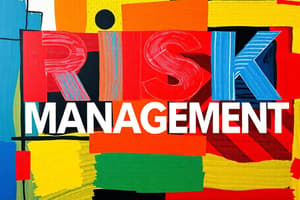Podcast
Questions and Answers
What is the primary objective of Common Cause Failure Analysis?
What is the primary objective of Common Cause Failure Analysis?
- To enhance employee training programs
- To evaluate the overall system performance
- To identify a single event or causal factor common to multiple components (correct)
- To assess the financial impact of accidents
Which analysis is used to identify potential failures based on the possible effects?
Which analysis is used to identify potential failures based on the possible effects?
- Failure Mode and Effects Analysis (FMEA) (correct)
- Preliminary Hazard Analysis
- Critical Incident Technique
- Fault Tree Analysis (FTA)
What does the term 'risk' denote in risk management?
What does the term 'risk' denote in risk management?
- The severity of damage caused by equipment failure
- The probability of an injury, loss, or hazard occurring (correct)
- The total number of hazards present in a workplace
- The potential consequence of a single event
What is the first step in the risk management process?
What is the first step in the risk management process?
Which of the following is NOT one of the main types of controls in risk management?
Which of the following is NOT one of the main types of controls in risk management?
Which of the following is NOT one of David Yates' broad categories when quantifying accident causes?
Which of the following is NOT one of David Yates' broad categories when quantifying accident causes?
According to Petersen's theory, what are the primary causes of accidents and incidents?
According to Petersen's theory, what are the primary causes of accidents and incidents?
Who is responsible for conducting an incident investigation?
Who is responsible for conducting an incident investigation?
Which principle is associated with the idea that work expands to fill the allotted time?
Which principle is associated with the idea that work expands to fill the allotted time?
What does the term 'Vicarious Liability' refer to?
What does the term 'Vicarious Liability' refer to?
Which of the following is NOT one of the Seven Cardinal Rules of Risk Communication?
Which of the following is NOT one of the Seven Cardinal Rules of Risk Communication?
What is an example of 'Fail Safe Passive' in system safety?
What is an example of 'Fail Safe Passive' in system safety?
What is the formula for calculating compensation cost?
What is the formula for calculating compensation cost?
Which of the following is NOT one of the steps in the Behavior-Based Safety process?
Which of the following is NOT one of the steps in the Behavior-Based Safety process?
Which condition is least likely to contribute to the likelihood of success in a safety program?
Which condition is least likely to contribute to the likelihood of success in a safety program?
Consequences that have the greatest impact on employee behavior are characterized by which of the following?
Consequences that have the greatest impact on employee behavior are characterized by which of the following?
What does an experience modification rate less than 1 indicate?
What does an experience modification rate less than 1 indicate?
Which of the following resources is NOT used for the extraction of critical behaviors?
Which of the following resources is NOT used for the extraction of critical behaviors?
What principle is NOT included in ISO 19011 for auditing?
What principle is NOT included in ISO 19011 for auditing?
What is the main difference between occurrence insurance and claims-made insurance?
What is the main difference between occurrence insurance and claims-made insurance?
Which calculation correctly describes the loss ratio?
Which calculation correctly describes the loss ratio?
What type of risk results in no possibility of financial gain and is beyond human control?
What type of risk results in no possibility of financial gain and is beyond human control?
What is a key goal of safety and health programs in the workplace?
What is a key goal of safety and health programs in the workplace?
Which analysis technique objectively identifies hazards within a system?
Which analysis technique objectively identifies hazards within a system?
What does risk homeostasis suggest about human behavior in relation to risk?
What does risk homeostasis suggest about human behavior in relation to risk?
What classification of cost refers to expenses that are visibly apparent?
What classification of cost refers to expenses that are visibly apparent?
Which method is an example of deductive analysis used in risk assessment?
Which method is an example of deductive analysis used in risk assessment?
Which statement about independent and mutually exclusive events is correct?
Which statement about independent and mutually exclusive events is correct?
What approach does dynamic risk assessments primarily involve?
What approach does dynamic risk assessments primarily involve?
Which of the following is a benefit of including health and safety considerations in cost-benefit analysis?
Which of the following is a benefit of including health and safety considerations in cost-benefit analysis?
Which source, message, channel, receiver model is related to effective communication?
Which source, message, channel, receiver model is related to effective communication?
What does ASTM International stand for?
What does ASTM International stand for?
Which principle states that work expands to fill the allotted time?
Which principle states that work expands to fill the allotted time?
Which type of control is primarily based on the knowledge and skills of employees?
Which type of control is primarily based on the knowledge and skills of employees?
What does a Z-score indicate in statistics?
What does a Z-score indicate in statistics?
Which of the following is NOT a type of fail-safe system?
Which of the following is NOT a type of fail-safe system?
What is Poka Yoke primarily used for?
What is Poka Yoke primarily used for?
What does NFPA stand for?
What does NFPA stand for?
Which principle states that 20% of employees are responsible for 80% of work and accidents?
Which principle states that 20% of employees are responsible for 80% of work and accidents?
An indemnification agreement primarily serves to protect which party?
An indemnification agreement primarily serves to protect which party?
Which organization helps establish Occupational Safety and Health management systems?
Which organization helps establish Occupational Safety and Health management systems?
Flashcards
Yates' Theory of Accident Causes
Yates' Theory of Accident Causes
A theory that categorizes accident causes into overload, inappropriate worker response, and inappropriate activities.
Petersen's Theory of Accidents
Petersen's Theory of Accidents
A theory stating that accidents occur due to human error or system failures, or a combination of both.
Vicarious Liability
Vicarious Liability
Holding someone responsible for an injury even if they didn't directly cause it, based on their relationship to the person responsible. This could apply to a supervisor who failed to adequately train or supervise an employee who caused the injury.
Peter Principle
Peter Principle
Signup and view all the flashcards
Parkinson's Principle
Parkinson's Principle
Signup and view all the flashcards
Pareto Principle (80/20 Rule)
Pareto Principle (80/20 Rule)
Signup and view all the flashcards
Fail Safe Passive
Fail Safe Passive
Signup and view all the flashcards
Loss Ratio
Loss Ratio
Signup and view all the flashcards
Experience Modification Rate (EMR)
Experience Modification Rate (EMR)
Signup and view all the flashcards
Behavior-Based Safety Process
Behavior-Based Safety Process
Signup and view all the flashcards
Consequences in Behavior-Based Safety
Consequences in Behavior-Based Safety
Signup and view all the flashcards
Safety Leadership
Safety Leadership
Signup and view all the flashcards
Integrated Safety Management System
Integrated Safety Management System
Signup and view all the flashcards
Employee Empowerment and Participation in Safety
Employee Empowerment and Participation in Safety
Signup and view all the flashcards
Safety Culture
Safety Culture
Signup and view all the flashcards
ISO 19011 Principles for Auditing
ISO 19011 Principles for Auditing
Signup and view all the flashcards
Risk
Risk
Signup and view all the flashcards
Hazard
Hazard
Signup and view all the flashcards
Risk Management Process
Risk Management Process
Signup and view all the flashcards
Critical Incident Technique
Critical Incident Technique
Signup and view all the flashcards
Sneak Circuit Analysis
Sneak Circuit Analysis
Signup and view all the flashcards
Components of a Safety and Health Program
Components of a Safety and Health Program
Signup and view all the flashcards
What is a pure risk?
What is a pure risk?
Signup and view all the flashcards
Who uses dynamic risk assessments?
Who uses dynamic risk assessments?
Signup and view all the flashcards
What is inductive analysis?
What is inductive analysis?
Signup and view all the flashcards
What is system availability?
What is system availability?
Signup and view all the flashcards
What are independent events?
What are independent events?
Signup and view all the flashcards
What are mutually exclusive events?
What are mutually exclusive events?
Signup and view all the flashcards
What is fault tree analysis?
What is fault tree analysis?
Signup and view all the flashcards
What is system hazard analysis?
What is system hazard analysis?
Signup and view all the flashcards
What are tangible costs?
What are tangible costs?
Signup and view all the flashcards
Indemnification Agreement
Indemnification Agreement
Signup and view all the flashcards
Ranking Departments by Composite Score
Ranking Departments by Composite Score
Signup and view all the flashcards
ABCs of Behavior: Antecedent, Behavior, Consequence
ABCs of Behavior: Antecedent, Behavior, Consequence
Signup and view all the flashcards
Types of Controls: Educational vs. Physical
Types of Controls: Educational vs. Physical
Signup and view all the flashcards
Avoidance Controls
Avoidance Controls
Signup and view all the flashcards
Poka Yoke
Poka Yoke
Signup and view all the flashcards
Study Notes
Dynamic Risk Assessments
- Workers commonly use dynamic risk assessments, which include emergency service workers, tradespeople, care workers, retail staff, and security operatives.
Formal Hazard Analysis
- Two types of formal hazard analysis include inductive and deductive.
- Inductive analysis is bottom-up, future-oriented, and hypothetical, based on experience and conclusions. Examples include FEMA, FEMCA, and FHA.
- Deductive analysis is top-down, future-oriented, and based on conclusions drawn from a number of premises. Examples include FTA, Fishbone, and General to Specific.
Cost Types
- Tangible costs are immediately visible and include purchasing products, paying employees, and equipment maintenance.
- Intangible costs are indirect and not immediately evident, but have future effects, such as risk.
Risk Management
- The definition of risk management is the eradication or minimization of the adverse effects of risks to which an organization is exposed.
- Risk homeostasis is the theory that people adjust their behavior in response to perceived risk levels to eliminate any discrepancies.
- System availability is the degree to which an item is operable and committable.
Analysis Techniques
- Fault tree analysis is a deductive analysis method that starts with a top-level event and works backward to identify causes.
- No single method can fully evaluate a product.
Control Measures
- Examples include avoidance of hazards, engineering or design changes to eliminate or control hazards, limiting personnel exposure to hazards, providing protective clothing and equipment, and providing warning signals.
Risk Management Process
- Key steps include hazard identification, hazard assessment, control development, decision-making, implementation, supervision and evaluation.
- Different types of controls include educational and physical controls.
Insurance
- Reinsurance: insurance between a primary and secondary insurer, with the secondary insurer covering some of the primary insurer's losses.
- Retrocession: the portion of risk or insurance amount the primary company chooses not to retain.
Human Factors Theory
- David Yates' theory categorizes accident causes into overload, inappropriate worker response and inappropriate activities.
- Incident investigations are the responsibility of front-line supervisors.
Accident/Incident Theory
- Petersen's theory states that causes of accidents are human error and/or system failure.
Vicarious Liability
- Assigns liability to a person who did not directly cause an injury but had a legal relationship with the negligent party.
Risk Communication
- Seven Cardinal Rules of Risk Communication (Covello and Allen 1988) include accepting the public as a partner, planning carefully, listening to concerns, being honest, working with credible sources, meeting media needs, and speaking compassionately.
Statistical Concepts
- Z score (Z): determines the location of a single score in a normal distribution.
- T-test (t): compares population mean to sample mean for data sets with fewer than 30 samples.
- Chi-square (X2): measures the goodness of fit between observed and expected frequencies, often used with frequency tables.
- Standard deviation (SD) provides the percentage area under a curve for one, two, and three standard deviations from the mean.
Miscellaneous
- ASTM, ANSI, NFPA, IARC: acronyms for various organizations dealing with standards, fire protection, cancer research.
Safety and Health Programs
- The main goal is to prevent workplace injuries, illness, and deaths.
Studying That Suits You
Use AI to generate personalized quizzes and flashcards to suit your learning preferences.




